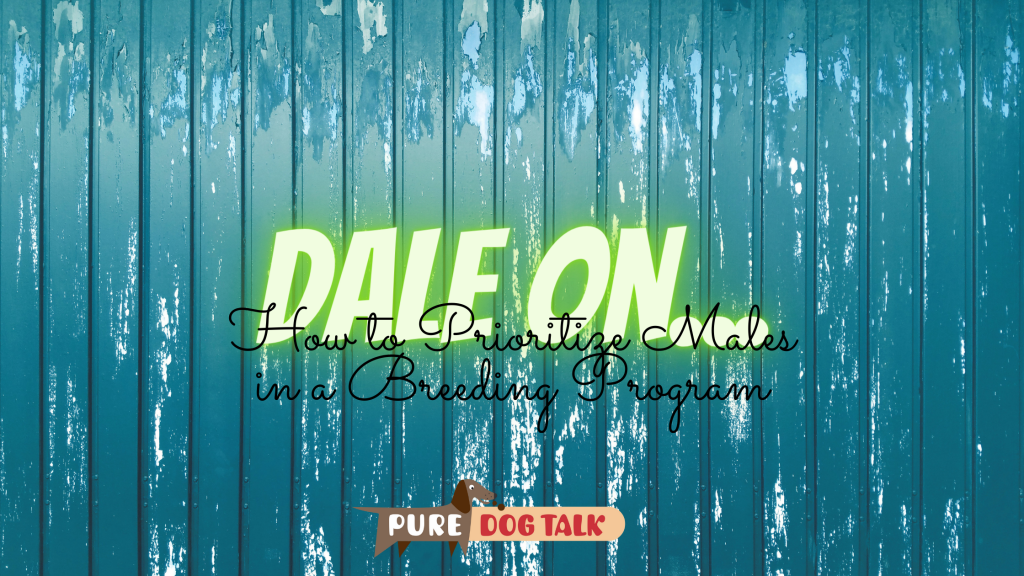544 — Rights and Responsibilities of the Stud Dog Owner
Rights and Responsibilities of the Stud Dog Owner
Dale Martenson of Touche Japanese Chin joins host Laura Reeves for a deep dive on the rights and responsibilities of the stud dog owner. The two long-time breeders break down the top five considerations for owners to consider as they decide whether and with which females to breed their male dogs.
Compensation
Stud dog owners typically will choose to either receive a stud fee or the choice of a puppy from the resulting litter in lieu of a stud fee. The amount of the stud fee, timing of when it’s paid and choice of puppy are all items up for discussion amongst the parties, Martenson noted, but whatever is decided should *always* be put in writing in a contract.
Pick and Choose
Owners of popular stud dogs will be in a position to select the ideal mates for their dog. But that requires having specific criteria, knowing the broad background of the breed, the pedigree of both dogs, the health, temperament and potential disqualifying faults and, finally, the ethics of the breeder with whom they are doing business.
Popular Sire Syndrome
Knowing what the “bottlenecks” are in a breed are part of the stud dog owner’s responsibilities. Population genetics come in to play as stud dog owners balance a desire to see beneficial aspects of their dogs used to strengthen the breed with a question of when does that become “too much” and impact the long-term health of the breed as a whole.
Preservation Breeding
Within small gene pools and truly rare breeds, owners of stud dogs will often make different decisions about allowing their dog to be used than owners of more popular breeds. For breeds with these “gene puddles,” the implications of using or not using a particular stud dog carry significantly more weight simply due to the sheer numbers or lack therof.
Relationship Building
“Establish a relationship (with the stud dog owner),” Martenson said. “Because I think right now, breeding requires more of a relationship than it did before. I think that you have to have that. You’re just not going to take a phone call and someone comes by with a brucellosis test and breed their bitch and take their check. That’s just not today’s environment.”
442 – How to Prioritize the Males in a Breeding Program
How to Prioritize the Males in a Breeding Program
Dale Martenson, renowned breeder at Touche Japanese Chin, joins host Laura Reeves for a conversation about when, why and how to prioritize male dogs in a breeding program. Everyone knows to keep a bitch. But it can be much more challenging to keep good stud dogs to move a breeding program forward.
With a shoutout to Kenny Rogers, “You gotta Know when to hold ‘em and know when to fold ‘em”…
“Every gambler knows
That the secret to survivin’
Is knowin’ what to throw away
And knowin’ what to keep
‘Cause every hand’s a winner
And every hand’s a loser”
“Most breeders have two or three bitches,” Martenson said. “But (if they) keep a male puppy, he’s too closely related to the mother, the sister and the aunt that they already have … so really what needs to happen, is people need to get a circle of friends together where they can keep stud dogs in kind of a joint ownership that they can share … because very quickly after you’ve used your dog once or twice you may not need that dog … your other option is you can go ahead and collect that dog, freeze it and put it on ice … so you can reuse that later on when your pedigrees are open enough to take it, when you’ve gone down the road a couple generations.
“We really have to try to keep as much diversity as possible (in our breeds) and it helps having those dogs available. But the other thin,g when you go to just use a stud dog and you haven’t bred from it, you really don’t know what you’re gonna get from that dog until you’ve had a couple of outcross litters, and a couple of line bred litters and you’ve watched the puppies grow up out of them. You won’t know your long run health testing for four or five years,” Martenson said. It’s a long range proposition, he added.
“We take such comfort in what we don’t know. Not knowing is like the blind faith in the universe that we’re not gonna worry ‘bout this it’s all gonna be fine… You go and you import something from another country … you don’t really know much of anything behind it… they’re pretty radical outcross and you just don’t know.”
For more of Dale’s take on prepotent sires, “name brand” sires, NOT breeding to ribbons and so much more, be sure to download and listen today.
441 – Veterinary Voice: Infertility in the Stud Dog
Veterinary Voice: Infertility in the Stud Dog
November is all about boy dogs! Dr. Marty Greer joins host Laura Reeves for a conversation about the causes of infertility in the stud dog. From poor collection technique to managing enlarged prostate and more uncommon problems, Greer provides invaluable insight into the causes and potential treatments of sterility or low fertility in male dogs.
“We can start with defining the difference between fertility, infertility and sterility,” Greer said. “Infertility is low fertility. Sterility is a permanent condition. So if your dog is sterile, there’s no going back. The implication is that his fertility is low and in some cases, not all but in some cases, we can restore fertility with the combination of appropriate diagnostic work up, appropriate intervention for medications and nutritional supplements and diet.
“So those are kind of the four hallmarks of what we can do for your stud dog. Sterile would be, by my definition, on more than one occasion doing a collection of the stud dog and getting no sperm. Zero live or dead sperm on multiple collections. So there may be sperm that are there that are dead. There may be sperm there in low numbers. But if you see absolutely no sperm on more than one occasion, and you think you had a pretty good collection based on his libido, then I would probably classify him a sterile. But we can certainly talk about some of the diagnostic testing that should be done.
“The sperm are made in the testicle and then the epididymis is the conduit by which the sperm leave the testicle and make it up into the urethra and are ejaculated. So it’s this series of really cool, tightly little coiled tubules that run on the backside of the testicle and up around and then into the urethra where the ejaculate comes from. So the epididymis, if it’s blocked somewhere in that on both sides, then you’re not going to get sperm.
Hands off the junk, lady!
Some young or inexperienced stud dogs may not fully ejaculate because “their head’s not in the game,” Greer noted. She shared tips for getting a better collection from the male.
“Mostly it’s practice. A lot of those are dogs that have been in pet type home, not a breeders type home. You basically need some practice. You need a dog that has a really good female in heat standing in front of him. A really cooperative female. So not a bulldog that’s making weird snorting noises, even if she’s nice, ’cause sometimes that’s misconstrued as a growl. Not a dog that’s going to turn around and kind of nibble at the boy. But a girl that’s going to back into him and send an engraved invitation, ‘hey big boy it’s over here.’ So you want to have an experienced, really cooperative, in heat, at the appropriate time in heat, female. That’s not always easy to achieve, as you know, you don’t always get to pull one off the shelf when you need one.”
Prostate myths
“Many people are confused about what to do with prostate disease,” Greer observed. “There’s basically four different categories of disorders we can see in the prostate. We can see benign prostatic hypertrophy, prostatitis, prostatic cysts and there can be cancer of the prostate. So those are the four general diseases that we see. A lot of dogs when they’re age 5 and older, when they’re around a female in heat … will stimulate the dog to develop some enlargement of his prostate. After age 5 will see these dogs stand up from laying down or walk into the house and blood will be dripping from the penis. Every veterinarian that doesn’t do reproduction says ‘oh OK, there’s two things we have to do here. One we have to put him on an antibiotic and two we have to neuter him.’ Well actually, both of those things are incorrect.”
440 – Successfully Collecting, Shipping and Freezing “Swimmers”
Successfully Collecting, Shipping and Storing “Swimmers”
Shannon and Sydney Stone from ICSB NorCal join host Laura Reeves for a detailed and educational conversation about collecting, shipping and freezing a stud dog’s semen, aka “swimmers.”
Mother and daughter share their vast experience with different extender media, freezing methods and tips and tricks for a successful collection of the stud dog.
Test drive extenders
For fresh chilled collections, Shannon strongly advocates for collecting a potential stud dog and doing a “chill test.” This enables the practitioners to save the semen in a variety of available media in order to be sure which one works best with the specific dog. Dogs are individuals and not all semen will survive in every media. It is critical to know this *before* that super important, exciting breeding that has been planned for years.
“It just basically boils down to finding the best media for your dog,” Shannon said. “There’s so many good medias on the market right now, it’s just what’s the best fit for your dog and what works best for you as a stud owner.
“Some of the best collections we see are ones where either the owner has a centrifuge or they took the dog to the vet and the collection is centrifuged and we’re only getting that sperm rich fraction added to the media.
“Kind of a rule of thumb that we’ve seen is, no matter what media you’re using, you can expect that … the loss of integrity to be about 20% per day that you’re holding a sample. So say you get a sample in on Friday or Saturday but the bitch really isn’t gonna be ready to breed til like Monday or Tuesday. We can check the semen and if we need to add a little bit, as long as we know what media was sent in, you can sometimes add a little fresh media to perk it up.
“What we say to our clients that are going to be shipping basically … a sample is always better in the bitch than in the box.”
Pellets vs straws
Frozen semen is stored in one of two methods. As “straws,” the original method developed by cattle breeders, often called “cattle straws” and “pellets” the method developed originally by ICSB. Sydney recommends, again, a freeze test to be sure which method is best for the individual stud dog.
The primary importance, Shannon noted, is to work with a veterinarian who is accustomed to the type of freezing method chosen. Thawing pellets and straws is two completely different processes. Using the wrong thaw method for the type of frozen semen will kill it immediately.
Collection Tips and Tricks
Technique, a teaser bitch and a relaxed stud dog are the keys to success, the team agreed.
“You have to know your dog and kind of change things up to accommodate him,” Shannon said. “It’s not one size fits all.”
Listen to our previous stud dog series with Shannon and Sydney here, here, here and here.




